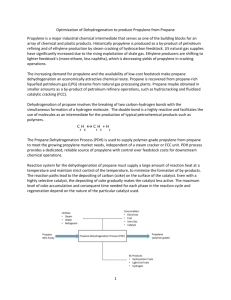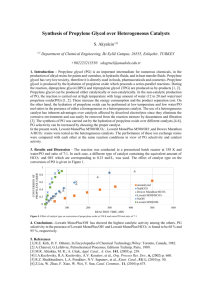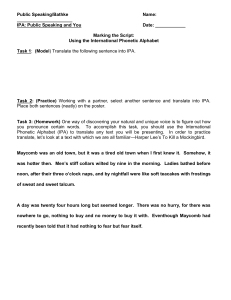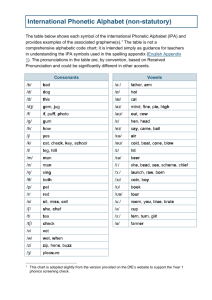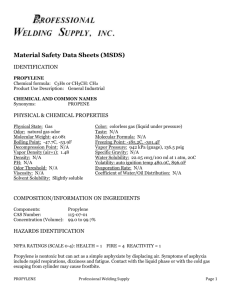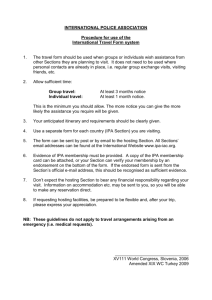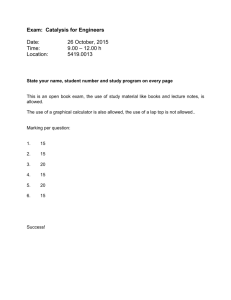Introduction - University of Alberta
advertisement
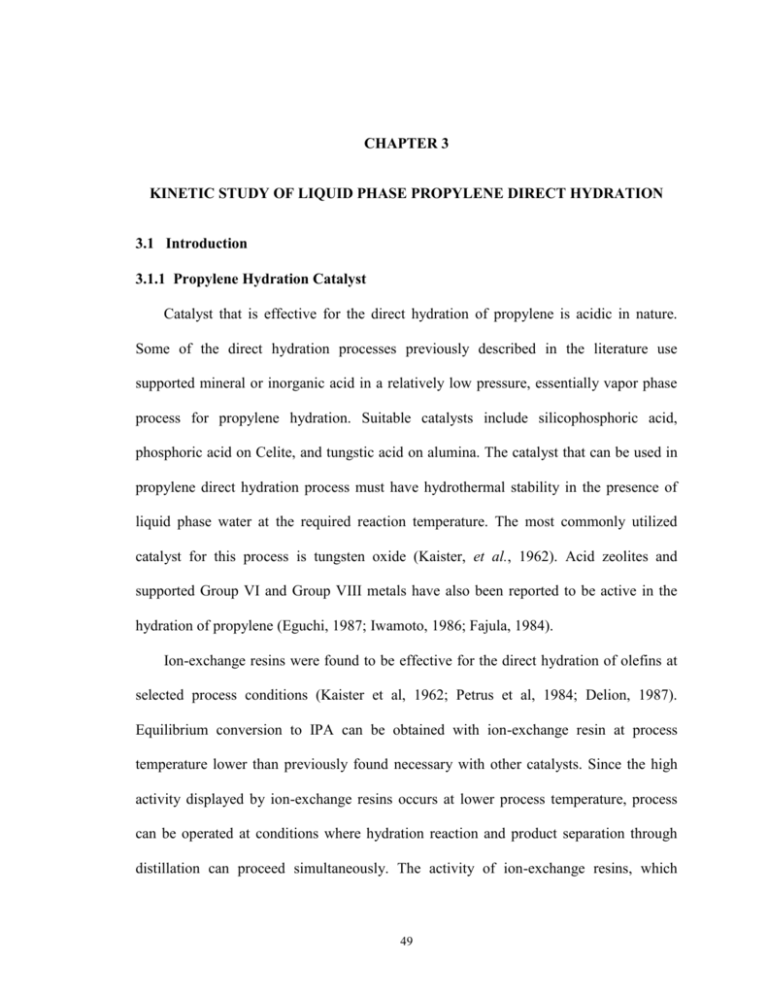
CHAPTER 3 KINETIC STUDY OF LIQUID PHASE PROPYLENE DIRECT HYDRATION 3.1 Introduction 3.1.1 Propylene Hydration Catalyst Catalyst that is effective for the direct hydration of propylene is acidic in nature. Some of the direct hydration processes previously described in the literature use supported mineral or inorganic acid in a relatively low pressure, essentially vapor phase process for propylene hydration. Suitable catalysts include silicophosphoric acid, phosphoric acid on Celite, and tungstic acid on alumina. The catalyst that can be used in propylene direct hydration process must have hydrothermal stability in the presence of liquid phase water at the required reaction temperature. The most commonly utilized catalyst for this process is tungsten oxide (Kaister, et al., 1962). Acid zeolites and supported Group VI and Group VIII metals have also been reported to be active in the hydration of propylene (Eguchi, 1987; Iwamoto, 1986; Fajula, 1984). Ion-exchange resins were found to be effective for the direct hydration of olefins at selected process conditions (Kaister et al, 1962; Petrus et al, 1984; Delion, 1987). Equilibrium conversion to IPA can be obtained with ion-exchange resin at process temperature lower than previously found necessary with other catalysts. Since the high activity displayed by ion-exchange resins occurs at lower process temperature, process can be operated at conditions where hydration reaction and product separation through distillation can proceed simultaneously. The activity of ion-exchange resins, which 49 appear to be superior solid catalyst for propylene hydration CD process, must be confirmed by experiment. Ion-exchange resins are cross-linked three-dimensional structures of polymeric substances obtained by sulphonaiton of copolymer made of polystyrene and divinyl benzene. They offer many advantages over other acid catalysts. The easy elimination of the reaction medium and the possible reutilization of ion exchange catalysts make them preferable to inorganic acids and bases. However, these resins are not suitable for use at temperature above 180°C. There are gel type and macroporous type resins. When the gel type resin is used in an aqueous solution, it is in highly expanded state and has highly developed pore structures, but when it is in contracted state, the pore structures are lost. While the “macro-reticular” pore structure built into the macroporous type resin is not lost when the resin is in its contracted state. 3.1.2 Reaction Mechanism Catalysis systems can be classified as homogeneous or heterogeneous. In homogeneous catalysis, a small catalyst molecule or ion is consumed in an early reaction step and is restored in a later step. In heterogeneous catalysis, the forces active at a solid surface distort or even dissociate an adsorbed reactant molecule to increase the rate of reaction. In the case of catalysis by ion exchange resins this classification is not as clearly defined (Helfferich, 1988). In macroporous resins, the reaction medium is distributed between gel and pores phases (Frankel, 1971). Chakrabarti and Sharma (1993) pointed 50 out that most resin-catalyzed reaction could be classified either as quasi-homogeneous or quasi-heterogeneous. Two approaches are followed for ion exchange resin catalyzed reactions. The first one envisions the resin to behave like a dissolved electrolyte. Reactions are treated as homogeneous reactions in the liquid phase. In the other approach, the resin is treated like a solid porous catalyst, in a manner similar to heterogeneous catalytic reactions. Kaiser (1962) studied the hydration of propylene in a trickle bed reactor using Amberlyst 15, a macroporous resin, and Amberlite IR-120, a gel type resin. When waterrich phase was the continuous one, both resins showed similar catalytic activity. A pseudo-first order model was obtained to represent the data in the kinetic study. Petrus (1984, 1986) studied the kinetics of the hydration of linear butenes and propylene over a strong acid ion-exchange resin and proposed a scheme with carbenium ion as intermediate. But Velo (1988) found in his study of the liquid-phase hydration of isobutene to tert-butyl alcohol that the reaction mechanism put forward by Petrus (1984) to account for the hydration of olefin seemed to fail in predicting the intrinsic rates in the case of isobutene hydration in the presence of large concentrations of product. The etherification reaction accompanied the propylene hydration was usually treated as an insignificant side reaction. Investigations on propylene hydration or IPA dehydration were carried out with excessive amount of water, and no appreciable amount of DIPE formed under those test conditions (Mourgues, 1967; Kuo, 1999; Kaister, 1962; Majewski, 1938). Kinetics on the etherification of olefins with 4 to 6 carbons with methanol or ethanol to produce ethers (MTBE, ETBE, TAME, TAEE) as important additives in gasoline were well studied (Rehfinger, 1990; Zhang, 1995; Rihko, 1997; 51 Subramaniam, 1987; Ancillotti, 1977; Linnekoski, 1997). Improved interpretation is often obtained using approaches traditional to heterogeneous catalysis and based on classical models such as Eley-Rideal type (E-R) and Langmuir-Hinshelwood type (L-H). In the study of liquid phase synthesis of MTBE from methanol and isobutene using the ion exchange resin catalyst, Amberlyst 15, Suvramaniam (1987) concluded that both homogeneous and heterogeneous kinetic models based on L-H type correlated the data of MTBE formation satisfactorily. Rihko (1997) found in his study of etherification of isoamylene with methanol that experimental results were best described by kinetic equations based on L-H model with alcohol and ether adsorbed on the catalyst surface and isoamylene reacted from the bulk liquid phase, while homogeneous reaction mechanism had the largest standard deviations of parameters. Linnekoski (1997) used three kinetic models: homogeneous, Eley-Rideal type, and Langmuir-Hinshelwood type to fit the measured reaction rates of liquid-phase formation of TAEE through reaction between ethanol and isoamylene catalyzed by the acid ionexchange resin (Amberlyst 16W). The statistics showed that L-H type model gave a better fit with experiment data. But the fit was not so good at low ethanol mole fractions (<0.4), which could indicate that the mechanism changes with decreasing alcohol mole fraction. 3.1.3 Effect of Polar Component on Reaction Mechanism The reaction mechanism occurring in the presence of resin depends on the polarity of the reaction medium, as shown by vapor phase kinetic studies carried out on dehydration 52 reactions of alcohols such as methanol, ternary butyl alcohol and IPA by Thronton (1974) and Gates (1973). Sonnemanes (1993) investigated the vapor phase hydration and etherification of propylene over acidic zeolites and concluded that the kinetics of propylene hydration over H-ZSM-5 was of a L-H type. The hydration and etherification reactions were significantly influenced by reactant adsorption. The catalytic activity of aluminum-rich H-ZSM-5 for both reactions decreased with increasing Brnsted acid site concentration (aluminum content) because the polar reactants became too strongly adsorbed. Linnekoski (1997) reported the formation of TAEE in the liquid-phase through reaction between ethanol and isoamylene catalyzed by the acid ion-exchange resin, Amberlyst 16W. When azeotropic mixture of ethanol and water was used as reactant, a decrease in the overall olefin conversion was observed. The change in conversion can be due to the competitive adsorption of water, ethanol and olefin. When water is added to the system it competes for the active sites with ethanol and olefin and fewer olefin are protonated by the active sites, which in turn results in lower conversion. Comparing with ethanol, water gives a more basic solvated proton of lower activity which gives lower overall conversion as indicated in the literature. It’s also observed that hydration yield (reaction between isoamylene and water) was about the same as the etherification yield (reaction between isoamylene and ethanol) although the ethanol/water molar ratio was as high as 11, indicating a competition between water and ethanol with protonated olefin. Water, as the stronger nucleophile, is preferred in the competition. The stronger nucleophilicity of water can be realized by comparing the dielectric coefficients of water and ethanol (Linnekoski et al, 1998). 53 The study on the liquid phase hydration of propylene over a gel type resin catalyst, Dowex 50WX8, was carried out by Heistand (1961). It was found that the addition of IPA to the feed resulted in a decrease of reaction rate. Typically the reaction rate decreased by about a factor of 2 when the mole fraction of IPA in the water-rich feed was increased from 0 to 0.1. Petrus (1986) studied liquid phase hydration of propylene catalyzed by Imac C8P at low IPA concentration (0.5%, 5%, 10 wt%). It was also found that the presence of IPA led to a larger reduction in reaction rate than expected. The kinetics of propylene hydration and IPA etherification is needed for the accurate modeling of the IPA production CD process. No study on the kinetics of liquid phase propylene hydration and IPA etherification over ion-exchange resin at high IPA concentration is available in literature. 3.2 Experimental 3.2.1 Experimental Apparatus All experimental runs were performed in a batch slurry reactor system (Figure 3.1). The reactor is a high pressure Parr reactor (Model 4841, Parr Instruments Inc. USA) made of SS-316 stainless steel. The reactor has a volume of 320 mL and is equipped with an impeller. A thermocouple (J-type) was used to measure reactor temperature. The heating device/controller was used to maintain a constant reactor temperature within 0.5K. Reactor pressure was measured using a pressure transducer (Foxboro electronic transmitter, Model 841 GM-D) at an accuracy of 1 psi. The liquid sampling line consists a 1/16 inch o.d. stainless steel tube in the reactor and a 1/8 inch o.d. stainless steel tube 54 outside of reactor connected to a stainless steel needle valve. The vapor sampling line was a 1/8 inch o.d. stainless steel tube connected to a needle valve. A septum was mounted by a nut and mental net on the outer tube at the end close to the reactor on each sampling line. The vapor sampling line was heated with heating rope to 393K. The end of the vapor sampling line was connected to a bubble flow meter, which was used to measure the amount of purged vapor. 3.2.2 Chemicals and Catalysts Isopropyl alcohol and diisopropyl ether were obtained from Aldrich in analytical reagent grade. They were used as received. Amberlyst 38, sulfated zorconia, zeolites 13X (Aldrich, 20,3864-7), SAPO-5 (MHZN2-34, Laval University, PQ, Canada) and silicalite with an alumina binder (S-115 Al2O3) were chosen for preliminary test. The preliminary test showed that Amberlyst 38 had a better activity and was chosen for detailed studies (Figure 3.2). The typical physical and chemical properties of Amberlyst 38 are listed in Table 3.1. 3.2.3 Analysis Techniques Both vapor and liquid samples were analyzed using a Hewlett Packard 5890 Series II Gas Chromatograph equipped with a thermal conductivity detector (TCD). A 30m0.32mm ID fused silica capillary column was used to separate water, propylene, IPA and DIPE in liquid samples. Vapor phase components were separated using a 1/8 inch o. d., 8 feet long column packed with 50-80 mesh Porapark R. Helium was used as carrier gas. 55 For the liquid sample analysis, the operating conditions for the gas chromatograph were: Temperature (C) Injector: 150 Detector: 150 Oven: 45, 2 min 50/min 180, 2 min The sample injection size was 2 L. The approximate retention time for the four components under the above operating conditions were: Water: 1.4 min Propylene: 1.9 min IPA: 4.4 min DIPE: 5.2 min For the vapor sample analysis, the operating conditions for the gas chromatograph were: Temperature (C) Injector: 150 Detector: 150 Oven: 110, 1 min 20/min 200, 2 min The approximate retention time for the four components under the above operating conditions were: Propylene: 3.8 min Water: 4.2 min IPA: 7.9 min DIPE: 14.3 min 56 3.2.4 Experimental Procedure In a typical kinetic reaction run, about 220 mL mixture of known amount IPA, deionized water, and DIPE was placed in the reactor. The ion-exchange resin catalyst, Amberlyst 38, was put into the reactor after washing with water, drying at 115°C for 5hrs and weighting. The reactor was then purged with helium to provide an inert atmosphere. The reactor was closed and heated to the desired reaction temperature, between 384421K. The stirrer was started at the moment the reactor content reached the set temperature and reaction time was set as zero. No corrosion of the reactor was observed. About 2µL of liquid sample and 35µL vapor phase sample were withdrawn from the reactor every 20-25 minutes for analysis. The time and the pressure of the sampling were recorded. Before sampling, the liquid sampling line was purged with about 1.0 mL liquid content of the reactor to make sure that sampling was not affected by dead volume in the sampling line. The vapor sampling line was purged with 1.5mL vapor content of the reactor. The pressure of the reactor was not significantly affected by the sampling process. Liquid sample was taken from the sampling line using a syringe and injected immediately into the GC. Vapor sample was taken from the vapor sampling line with a SUPLCO sample lock syringe and injected into the GC immediately. Syringe adaptors were used to ensure that same amount of sample was taken for analysis each time. The amount of liquid and vapor removed from the reactor was negligible. The pressure of the system increased as the propylene and DIPE were produced while reactions proceeded. The pressure can rise to 350 psig or more depending on reaction temperature, initial mixture composition and catalyst loading. The molar ratios of initial feed components were DIPE: IPA : water =2-1.2:1.8-0.7:1. 57 For the tests of vapor-liquid equilibrium of propylene-water-IPA-DIPE fourcomponent system, a mixture of IPA-water-DIPE was charged into the reactor. The gas inlet and outlet valve were opened to purge the reactor with propylene for 5 seconds. Then the gas outlet valve was close to filled the reactor with propylene. Stirrer was started to facilitate the solving of propylene into the liquid mixture. The initial pressure of the reactor was 110-180 psig. The system was heated to the desired temperature (393423K) and maintained at steady state for 1.5 hours to ensure that phase equilibrium has been reached before vapor and liquid phase sample were taken for analyses. 3.3 Results and Discussion 3.3.1 Catalyst Screening The dehydration of IPA is widely used as a reaction to qualitatively characterize the activity of solid catalyst and to study the mechanism of the catalytic dehydration of alcohols over solid acids. Those studies provided useful information concerning the activity of catalyst for propylene hydration and etherification reactions. Rivard (2000) studied the performance of the well known acid catalysts including alumina, zeolites 13X, SAPO-5 and silicalites in IPA dehydration reaction with an initial IPA concentration of 10 wt% at 463K. Silicalite with an alumina binder (S-115 Al2O3 ExT.) was found to be the most active catalyst among the catalysts tested. Kaiser et al. (1962) concluded from experimental results of propylene hydration over ion-exchange resin that conversion and selectivity similar to those obtained with inorganic catalysts could be obtained with ion-exchange resins at milder conditions of lower temperatures and pressures. Two strong acidic ion-exchange resins of the sulfonic acid type (Rohm and Hass Co., Amberlyst 15 and IR-120) were used. The Amberlyst 15 differs from the IR- 58 120 in that it has a “macro-reticular” pore structure built into the resin which is not lost when the resin is in its contracted state. Neither resin was found to be significantly different from the other in any of the areas examined in the study. This was attributed to the fact that the resins were in an aqueous solution, where both resins were in highly expanded states and had highly developed pore structures. Catalysts chosen for the preliminary tests were Amberlyst 38, a strong acidic ionexchange resin reported to be thermally stable up to 433K, Silicalite with an alumina binder (S-115 Al2O3 ExT.), zeolites 13X (Aldrich, 20,3864-7), SAPO-5 (MHZN2-34, Laval University, PQ, Canada) and sulfated zorconia. Test runs were carried out at 411K. Amberlyst 38 was found to be the most active catalyst among the screened samples (Figure 3.2). 3.3.2 Mass Transfer Limitations Heterogeneous catalytic reactions can be said to occur through the following steps 1. transport of reactant material(s) from bulk liquid through boundary layer to the catalyst surface 2. diffusion of the reactant(s) through the pores to the active catalyst surface 3. adsorption of the reactant(s) onto the active site(s) 4. catalytic surface reaction to form reaction product(s) 5. desorption of product(s) from the active site(s) 6. diffusion of reaction product(s) through the pores to the catalyst surface 7. transport of the product(s) through boundary layer to the bulk media 59 The external mass transfer is described in steps 1 and 7. Internal mass transfer through the porous catalyst via molecular and Knudsen diffusion is described in steps 2 and 6. The reaction, which consists of the adsorption/desorption of the reactants/products and the surface reaction are detailed in steps 3-5. The observed rate of reaction depends on all of the above steps. True surface reaction rates can only be determined if the experiments are performed under conditions where the observed rate is not limited by diffusional processes. 3.3.2.1 Effect of Stirring Speed The region where the external mass-transfer is no longer rate limiting was determined by varying the stirrer speed. The rotating speed of the stirrer in the reactor was changed while initial charge of reactants and catalyst remain the same (220mL IPA, DIPE and Water mixture, DIPE:IPA: water=1.5:1.8:1, catalyst loading 3.8 wt %, 421K). During the pre-trial runs, it was found that the stirrer speed had no effect on the reaction rate above stirring speed 800rpm at the above reaction conditions (Figure 3.3). When the stirred speed was reduced to 150rpm, the pressure of the reactor increased faster than that of stirring speed of 800rpm or 1200rpm. The possible reason was that the vapor and the liquid phase in the batch reactor were not in vapor-liquid equilibrium as we assumed when low stirring speed was employed. Propylene and DIPE formed in liquid phase escaped into vapor phase without saturating the liquid due to the lake of agitation. A test was repeated to verify our suspect. A 150 mL mixture of DIPE, IPA and water at a molar ratio of 1.5:1.8:1 was charged into the reactor. The vapor phase was first purged with helium, and then filled with helium, which is of negligible solubility in the mixture. 60 The pressure changes of the closed system with time with no stirring and a stirring speed of 1200rpm were recorded. Similar tests were performed again but with vapor phase filled with propylene. It can be seen from Figure 3.4 that the pressure of the system remained the same as time elapsed when vapor phase was filled with helium. Stirring of liquid made no difference to the system pressure. When the vapor phase was filled with propylene and no stirring of liquid was provided, the pressure of the system decreased gradually as time passed by. In the case of stirring, the pressure of the system with a propylene vapor phase decreased drastically and reached steady point within 0.5 minute. The results of this test (Figure 3.4) proved that stirring facilitated the dissolution of propylene into the liquid, therefore accelerated the vapor-liquid equilibrium process. Stirring affects not only external mass transfer but also the vapor-liquid equilibrium of the system. Sufficient stirring speed should be used to ensure that reactants and products in vapor and liquid phase are in equilibrium and reactions are carried out in the zone of no external mass transfer effect. In all experimental runs, a stirrer speed of 1200rpm was employed to eliminate the effect of stirring speed on the overall reaction rate and the equilibrium state of vapor and liquid phases. In reaction runs, propylene was produced gradually and samples were taken to determine the compositions of both liquid and vapor, the retention time of propylene solving into liquid (0.5min) do not affect experimental results. 3.3.2.2 Effect of Catalyst Particle Size The region where the internal mass-transfer is not rate limiting was determined by varying the catalyst particle size. Tests at 421K with catalyst loading of 3.8 wt% and 61 DIPE: IPA: water ratio of 1.5:1.8:1 indicated that internal mass transfer was not rate limiting at particle size ranges of 20-40 and 40-100 mesh under the test conditions (Figure 3.5). The macro structure in Amberlyst 38 permits ready access of liquid reactants to active sites present throughout the resin beads. There is no major resistance for the reactants to diffuse into the pores and the products to diffuse out under the test conditions. 3.3.3 Reusability of Catalyst Amberlyst 38 resin can be used at temperature up to 433K. General desulfurization resulting in loss of activity may be evident at higher temperature. To avoid fouling, poisoning or degradation, it is necessary to prevent the catalyst from the contact with colloidal particles, inorganic salts and organic peroxides to prevent deactivation of the catalyst. In this study, precautions were taken to prevent the decrease on the catalyst effectiveness. The reusability test was conducted by using the same catalyst in two runs with similar operation conditions (220mL DIPE, IPA and Water mixture, DIPE: IPA: water=1.5:1.8:1, catalyst loading 3.8 wt%, 421K). Figure 3.6 shows the results from these two runs. No indication of deactivation was observed for the reused catalyst. 3.3.4 Catalyst Loading The effect of catalyst loading on the rates of propylene and DIPE formation was determined by performing kinetic runs at catalyst loadings of 1.8 wt%, 2.7 wt% and 3.8 wt%. The experiments were performed at 421K with DIPE: IPA: water initial ratio of 62 1.5:1.8:1. As can be seen in Figure 3.7, the calculated kinetic parameters were not affected by catalyst loading. 3.4 Kinetic Modeling 3.4.1 Calculation of Reaction Rate The system we studied involves two reactions in series while each of them is reversible. The rate of the reversible hydration and etherification are expressed in terms of propylene and DIPE. The rate of propylene and DIPE formation per gram of catalyst per minute in a batch slurry reactor can be written in the following manner: ri 1 dN i mc dt (3.1) The content of batch slurry reactor consists of a liquid phase where hydration and etherification proceed over the suspended solid catalyst and a vapor phase where the reactants, products and inert are present. It is assumed that the amount of inert, helium, dissolved in liquid phase was negligible. The total amount of propylene and DIPE formed at the time corresponding to each sampling was calculated using the equations of material balance. Mass balance: Ma(L*xa+V*ya)+ Mw(L*xw+V*yw)+ Mp(L*xp+V*yp)+ Me(L*xe+V*ye) = Mtotal (3.2) Chemical Reaction: L(xp+2xe)+ V(yp+2ye) = Na0+ 2Ne0-(L*xa+V*ya) 63 (3.3) 3.4.2 Determination of Rate Equation Homogeneous Approach By combining terms and using the equilibrium constants for the reactions, we obtain the rate equations for the formation of IPA and DIPE in the expression of homogeneous systems: rp=k11(CwCp-Ca/KE1) (3.4) re=k22 (Ca2-CeCw/KE2) (3.5) Heterogeneous Approach The rate laws developed for surface catalysis are based on the following assumptions: 1. The surface of the catalyst contains a fixed number of site; 2. All the active sites are identical; 3. The activities of these sites depend only on temperature. They do not depend on the nature or amounts of reactants and products present on the surface during the reaction. Langmuri-Hinshelwood (L-H) kinetics is derived by assuming that the surface coverage in catalytic rate laws is given by the equilibrium coverage, which exists in the absence of the surface reaction. The resulting rate expressions find wide use in the chemical industry because they exhibit many of the commonly observed features of surface-catalyzed reactions. Propylene hydration and IPA etherification can be represented by the following mechanism: 64 propylene s p propylene s (3.6) Kw water s water s (3.7) Ka IPA s IPA s (3.8) Ke DIPE s DIPE s (3.9) K k k 1 1, 1 propylene s water s IPA s s (3.10) 1 k2 ,k2 2IPA s DIPE s water s (3.11) The L-H model assumes that the reaction takes place between reactants adsorbed on two acid sites. Of all these elementary reaction steps (Equations 3.6-3.11), one step is considered to be rate-determining, all other steps are considered to be at equilibrium. When surface reactions (3.10) and (3.11) are the rate-determining steps, the overall rate of hydration and etherification can be expressed in terms of propylene and DIPE formation rate using the fraction of sites occupied by adsorbed components as: rp k11 a v k1 p w (3.12) re k 2 a2 k 21 e w (3.13) The rate of adsorption of component i is given by the Langmuir model as: rads(i ) K ads(i ) v Ci K dea (i ) i (3.14) where the fraction of active sites which are vacant, v, can be expressed as: v 1a w p e (3.15) The rates of adsorption of all the components are considered to be at equilibrium. Setting Equation 3.14 to zero yields: 65 i K i v Ci (3.16) The equilibrium adsorption constant for component i, Ki, is defined as: Ki K ads( i ) (3.17) K dea ( i ) The fraction of active sites occupied by component i can be written as: i K i Ci v K i Ci 1 K i Ci (3.18) then the formation rates of propylene and DIPE are: rp re k11 K a C a k1 K p K w C w C p (1 K a C a K w C w K p C p K e Ce ) 2 k 2 K a2 C a2 k 21 K w K e C w Ce (1 K a C a K w C w K p C p K e Ce ) 2 (3.19) (3.20) Eley-Rideal (E-R) type of rate models assumes that the reaction takes place between one molecule adsorbed on one acid site and one nonadsorbed molecule from the liquid phase: k k 1 1, 1 propylene water s IPA s (3.21) 1 k2 ,k2 IPA s IPA DIPE water s rp re k11 K a C a k1 K wC p C w 1 K a C a K w C w K p C p K e Ce k 2 K a2 C a2 k 21 K w C w C e 1 K a C a K wC w K p C p K e Ce 66 (3.22) (3.23) (3.24) In these models the summation in the denominator accounts for all the adsorbed species that share the largest portion of acid sites. L-H type and E-R type models with adsorption as rate-determining step can be obtained using the same procedure. Taking adsorption as rate-determining step, reaction rate can be written as Equation 3.14. According to Helfferich (1962), the adsorption of the strongly polar components on ion exchange resin are much stronger than the adsorption of the less polar components. Rehfinger (1988) performed study on adsorption behavior of n-butane, 1-butene and methanol on ion exchange resins. Sorption and swelling experiments confirmed the highly selective methanol absorption into the gel microspheres. Over the whole concentration range of interest, only the alcohol was in the gel phase and other components were displaced. In pure liquids the amount of methanol moles adsorbed is about 3.5 times that of 1-butene. The ratio was independent of the degree of cross-linking of the resin. Liquid phase adsorption experiments conducted for methanol, ethanol, C5 and C6 olefins and dibutyl-ethers on ion-exchange resin by Zhang (1995) provided direct experimental evidence validating the most abundant surface species assumption for ethanol and the neglect of the olefin and ether adsorption in rate expressions. To simplify the equations, term KpCp+KeCe is omitted as it was later calculated to be 0.7-1.2% of the term 1+KaCa+KwCw from experimental data. The rate equations can be simplified to: L-H type: rp k11 K a Ca k1 K w K p C wC p (1 K a C a K wC w ) 2 K p1C a K p 2 C wC p (1 K a C a K w C w ) 2 67 (3.25) k 2 K a2 C a2 k 21 K w K e C w C e K e1C a2 K e 2 C w C e re (1 K a C a K w C w ) 2 (1 K a C a K w C w ) 2 (3.26) E-R type: rp k11 K a C a k1 K w C wC p 1 K a Ca K wCw K p1C a K p 2 C wC p 1 K a Ca K wCw k 2 K a C a2 k 21 K w C w C e K e1C a2 K e 2 C w Ce re 1 K a Ca K wCw 1 K a Ca K wC w (3.27) (3.28) with Kp1=k1-1Ka, Kp2=k1Kw, Ke1=k2Ka, Ke2=k2-1Kw for E-R model and Kp1=k1-1Ka, Kp2=k1KwKp , Ke1=k2Ka2, Ke2=k2-1KwKe for L-H model. The familiar power law model usually used for homogeneous reaction can be deduced from the L-H or E-R model for heterogeneous reaction by assuming that the adsorption is weak for all components. Assuming 1+KpCp+KeCe+ KaCa+KwCw1, the rate equations become: rp= Kp1Ca-Kp2Cw Cp= k11(CwCp-Ca/KE1) (3.29) re= Ke1Ca2-Ke2CwCe= k22 (Ca2-CeCw/KE2) (3.30) 3.4.3 Estimation of Parameters Experimental reaction rate data was processed using a nonlinear regression method with the kinetic models described in Section 3.4.2. The sum of squares was the minimized variable and was calculated as the sum of the squares of the difference between the predicted and experimental values. For each reaction temperature, 25-34 data points were used to calculate the parameters. The standard difference between the 68 predicted and experimental values was used to evaluate the quality of the model in relation to the prediction of the reaction rate. Simplified E-R model with surface reaction as rate-determining step (Equations 3.27 and 3.28) gave the best fit of the data (Table 3.2). The effect of temperature on reaction rate was modeled using the Arrhenius expression. The parameters of E-R model are: Kp1=1.297E30*EXP (-31913/T) (3.31) Kp2=1.245E22*EXP (-24321/T) (3.32) Ka=8.310E-2*EXP (-1942/T) (3.33) Kw=3.539E-46*EXP (44554/T) (3.34) Ke1=6.360E-27*EXP (23886/T) (3.35) Ke2=5.481E-85*EXP (69989/T) (3.36) The kinetic model should not only be able to fit the experimental data, but it should be able to predict IPA conversion under different conditions. Additional kinetic runs were carried out at 418K. The kinetic parameter established using previous runs were used to predict the rate of IPA conversion at other initial concentration and temperature conditions. It can be seen from Figure 3.8 that E-R model is able to predict the IPA conversion well. The average stander error of the prediction is 8.4%. 3.5 Vapor-liquid Equilibria of Propylene-Water-IPA-DIPE System The vapor-liquid equilibrium experimental results were compared with the prediction of the commercial simulation package AspenlusTM to verify the prediction under the interested conditions. The built-in operation unit ‘Flush’ using UNIFAC method was 69 used to calculate the vapor and liquid phase composition under the same conditions as those of equilibrium experiments. The predicted data has an average standard error of 7.3% with experimental results (Figure 3.9). It is therefore believed that UNIFAC method is able to accurately predict the phase behavior of the propylene-water-IPA-DIPE system under the condition of interest (393-423K, 200-300psi). 3.6 Conclusions The reaction kinetics for the hydration of propylene and etherification of IPA were studied using Amberlyst 38 as catalyst. The effects of stirring speed, temperature, catalyst loading and catalyst particle size on reaction rate were investigated. It was found that external mass transfer resistance to the reactions can be eliminated by increasing stirring speed beyond 800rpm. The internal mass transfer resistance is not significant under the test conditions. The kinetic reaction rate equations were developed using an Eley-Rideal model. The equations can be used in the design of catalytic distillation process for IPA production through propylene hydration. 70 3.7 Nomenclature C liquid phase concentration mole/l fi*,l liquid fugacity of pure component i at mixture temperature ViG partial mole volumes k1 propylene hydration rate constant k2 IPA etherification rate constant k11 IPA dehydration rate constant k 21 DIPE decomposition rate constant K adsorption rate constant L mole number of liquid phase Mi molecular weight of component i mc mass of catalyst gram N moles of compounds mole Ni0 mole number of reactant i charged into batch reactor r reaction rate mole/min.g catalyst t reaction time minute V mole number of vapor phase xi liquid phase mole fraction of component i yi vapor phase mole fraction of component i i liquid activity coefficient of component i iv vapor phase fugacity coefficient of component i 71 I fraction of vacant sites i fraction of active sites occupied by component i Subscripts a - IPA e - DIPE p - propylene w - water 72 3.8 Literature Cited Ancillotti, F., Mauri, M. M., Pescarollo, E., 1977, Ion Exchange Resin Catalyzed Addition of Alcohols to Olefins, Journal of Catalysis, 46, 49-57. Chakrabarti, A., Sharma, M. M., 1993, Cation Ion Exchange Resin as Catalyst, React. Polym., 20, 1-45. Delio, A., Torch, B., Hellin, M., 1987, Hydration of Isopentenes in an Acetone Environment over Ion-exchange Resin: Thermodynamic and Kinetic Analysis, Journal of Catalysis, 103, 177-187. Eguchi, K. T., Aria, H., 1987, High Pressure Catalytic Hydration of Olefins over Various Proton-Exchanged Zeolites, J. Catal., 34, 275-287. Fajula, F. R., Ibarra, Figueras, F., Guegen, C., 1984, Hydration of n-Butenes Using Zeolites Catalysts, J. Catal., 89, 60-68. Frankel, L. S., Nuclear Magnetic Resonance Study of Ion-Exchange Resins, J. Phys. Chem., 1971, 75, 1211-1214. Gates, B.C., Rodriguez, W., General and Spedific Acid Catalysis in Sulfonic Acid Resin, J. Catal., 1973, 31, 27-31. Gonxale, J. C., Fair, J. R., 1997, Preparation of Tertitiary Almyl Alcohol in a Reactive Distillation Cloumn. 1. Reaction Kinetics, Chemical Equilibrium, and Mass-Transfer Issues, Ind. Eng. Chem. Res. 36, 3833-3844. Helfferich, F.,1962, Ion Exchang, McGraw-Hill, New York, P511-512. 73 Iwamoto, M., Tajima, T., Kagawa, S., 1986, Gas Phase Direct Hydration Of Ethylene Over Protone Exchanged Zeolites Catalysts At Atmospheric Pressure, J., Catal., 101, 195-200. Kaiser, J. R., Beuther, H., Moore, L. D., Odioso, R. C., 1962, Direct Hydration of Propylene over Ion-Exchange Resins, I&EC Product Research and Development, 1(4), 296-302. Kuo, Y., Chen Y., Isopropyl Alcohol Dehydration over Chrominophosphate Catalysts-1. A. Kinetic Study, 1999, J. Chin. Chem. Engrs., 30(5), 421-429. Linnekoski, J. A., Krause, A.O., 1997, Kinetics of the Heterogeneously Catalyzed Formation of tert-Amyl Ethyl Ether, Ind. Eng. Chem. Res., 36, 310-316. Linnekoski, J. A., Krause, A.O. I., Struchmann, L. K., 1998, Etherification and hydration of isoamylenes with ion exchange resin. Applied Catalysis A General, 170, 117-126. Majewski, F. M., Marel, L. F., 1938, Hydration of Propylene under Pressure, Industrial and Engineering Chemistry, 30(2), 203-210. Mourgues, L., Peyron, F., Trambouze, Y., 1967, Kinetics of the Catalytic Dehydration of 2-Propanol, Journal of Catalysis, 7, 117-125. Petrus, L., De Roo, R. W., Stamhuis, E. J., Joosten, G. E. H., 1984, Kinetics and Equilibria of The Hydration of Propene over a Strong Acid Ion Exchange Resin as Catalyst, Chemical Engineering Science, 39(3), 433-446. Petrus, L., De Roo, R. W., Stamhuis, E. J., Joosten, G. E. H., 1986, Kinetics and Equilibria of The Hydration of Linear Butenes over a Strong Acid Ion Exchange Resin as Catalyst, Chemical Engineering Science, 41(2), 217-226. 74 Rehfinger, A., Hoffmann, U., 1990, Kinetics of Methyl Tertiary Butyl Ether Liquid Phase Synthesis Catlyzed by Ion Exchabge Resin- I. Intrinsic Rate Expression in Liquid Phase Activities, Chemical Engineering Science, 45(6), 1605-1617. Rihko, L. K., Kiviranta-Paakkonen, P. K., Krause, A. O., 1997, Kinetic Model for the Etherification of Isoamylene with Methanol, Ind. Eng. Chem. Res. 36, 614-621. Sonnemanes, M. H. W., 1993, Hydration and Etherification of Propene over H-ZSM-5. 1. A Kinetic Study, Ind. Eng. Chem. Res., 32, 2506-2511. Sonnemanes, M. H. W., 1993, Hydration of Propene over Acid Zeolites, Applied Catalysis A: General, 94, 215-229. Suvramaniam, C., Bhatia, S., 1987, The Canadian Journal of Chemical Engineering, 65, 613-620. Thronton, R., Gates, B. C., 1974, Catalystsis by Matrix Bound Sulfonic Acid Groups: Olefin and Paraffin Formation From Butyl Alcohols, J. Catal., 34, 275-287. Zhang, T., Datta, R., 1995, Ethers from Ethanol. 4. Kinetics of the Liquid-Phase Synthesis of Two tert-Hexyl Ethyl Ethers, Ind. Eng. Chem. Res., 34, 2247-2257. Velo, E., Puigjaner, L., Recasens, F., 1998, Inhibition by Production in the Liquid-phase Hydration of Isobutene to tert-Butyl Alcohol: Kinetics and Equilibrium Studies, Ind. Eng. Chem. Res., 27, 2224-2231. 75 Gas Outlet P T Vapor Sampling Line Liquid Sampling Line Gas Inlet Figure 3.1 Batch slurry reaction system Stirrer High Pressure Reactor 76 8 Total conversion of IPA (%) 7 6 5 4 3 Amberlyst 38 silicalitet, zeolite, SAPO-5 2 sulfated zorconia 1 0 0 20 40 60 80 100 120 Time (min) Figure 3.2 Catalyst screening 77 140 160 260 System pressure (psig) 240 220 200 180 160 stirring speed=800rpm 140 stirring speed=1200rpm 120 stirring speed=150rpm 100 80 0 20 40 60 80 100 Time (min) Figure 3.3 Effect of stirring speed 78 120 140 160 140 System pressure (psig) 120 100 80 60 helium, 0rpm helium,1200rpm 40 propylene, 0 rpm propylene,1200rpm 20 0 0 1 2 3 4 5 6 7 8 9 Time (min) Figure 3.4 Effect of stirring speed on vapor liquid equilibrium 79 10 Total conversion of IPA (%) 12 10 8 6 4 particle size 40~100mesh particle size 20~40mesh 2 0 0 20 40 60 80 100 120 140 Time (min) Figure 3.5 Effect of particle size on the overall reaction rate 80 160 Total conversion of IPA (%) 12 10 8 6 4 fresh catalyst used catalyst 2 0 0 20 40 60 80 100 Time (min) Figure 3.6 Catalyst reusability 81 120 140 160 Logarithm of parameter 4 2 0 ln(Kp1) ln(Kp2) -2 ln(Ka) ln(Kw) -4 ln(Ke1) ln(Ke2) -6 -8 -10 1.0 1.5 2.0 2.5 3.0 3.5 Catalyst loading (%) Figure 3.7 Effect of catalyst loading 82 4.0 Total conversion of IUPA (%) 12 10 8 6 4 experimental data prediction 2 0 0 30 60 90 120 150 180 Time (min) Figure 3.8 Comparison of experimental data with rate equation predicted conversion 83 UNIFAC predicted vapor phase mass fraction 0.8 0.6 0.4 water propylene DIPE IPA 0.2 0 0 0.2 0.4 0.6 0.8 Experimental vapor phase mass fraction Figure 3.9 Comparison of experimental data with UNIFAC predicted data 84 Table 3.1 Property of Amberlyst 38 Physical form Ionic form as shipped Concentration of acid sites Moisture holding capacity Shipping weight particle size Harmonic mean size Uniformity coefficient Finest content Coarse beads Surface area Porosity Average pore diameter Temperature stability 85 opaque beads hydrogen >1.9eq/L; >5.3eq/Kg 51-57% 810g/L 700-900um <1.60 <0.425mm: 1.9% max >1.180mm: 8.0% 35m^2/g 0.30ml/g 20nm up to 160 °C Table 3.2 Comparison of kinetic models Model type L-H L-H E-R E-R Power law rate-determin step surafce reaction adsorption surafce reaction adsorption 86 Standard error (%) 14.6 19.8 8.1 15.7 24.8 CHAPTER 4 CONCLUSIONS AND RECOMMENDATIONS 4.1. Conclusions Catalytic distillation was applied to the production of IPA through propylene direct hydration. The optimum operating parameters for this catalytic distillation process were determined using a computer model. The simulation results show that the use of a catalytic distillation process overcomes chemical reaction equilibrium and vapor-liquid equilibrium limitations. The model shows that high purity IPA (up to 99.9 mol%) can be produced as a liquid product stream containing virtually no water. The reduction of water below the IPA-water azeotrope water content occurs by reaction of water with a 2.9:1 optimum molar excess of propylene when using a CD column having two spaced apart catalyst beds. Excess propylene is recycled to remove impurities that may otherwise accumulate in the CD column. The equilibrium ether content of the reaction mixture is retained in the reaction zones in the middle of the column therefore reduced the effect of side reaction. The optimum operation pressure is 2 MPa for the CD column, and the column temperature range is 323-460K, to allow simultaneous reaction and separation of the reaction mixture. The reaction kinetics for the hydration of propylene and etherification of IPA were investigated using Amberlyst 38 as catalyst. The reactions were carried out in a batch reactor. IPA, water and DIPE were used as initial reactants. Reaction rates were express as the formation rate of propylene and DIPE. The effects of stirring speed, temperature, catalyst loading and 87 catalyst particle size on reaction rate were studied. L-H, E-R and power law mechanisms were proposed and screened. Eley-Rideal model was found to best describe the kinetic data. 4.2. Recommendations for Future Work Future work should focus on design of a small-scale catalytic distillation column, laboratory experiments on the column, dynamic simulation and applications to industrial processes. A noequilibrium model incorporating tray efficiency and kinetic equation would be able to predict the behavior of the CD process more accurately. A lab scale CD column should be designed and experimental data about the tray efficiency should be gathered. Amberlyst 38 was used as propylene hydration catalyst, which is in the form of small beads. CD column internal should be carefully designed to ensure the high efficiency of catalyst beds. The interaction between the chemical and phase equilibrium creates control problems not generally occur with conventional distillation. Tight process control may be required. Dynamic simulation of the process is needed to develop successful process control scheme. 88 Appendix Input and Output Files for the Simulation of Catalytic Distillation Using Aspen PlusTM 89
